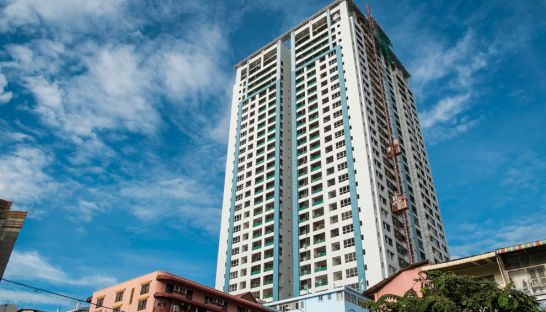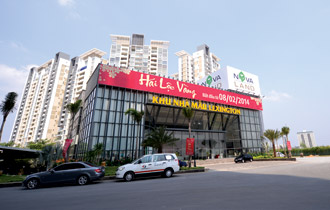Phnom Penh’s growing condominium conundrum
Phnom Penh’s growing condominium conundrum
Looking at Phnom Penh’s skyline at night, the capital’s luxury condominiums immediately come into view, soaring above the apartment blocks and narrow townhouses most residents call home.

But a closer look reveals that many of the sleek buildings’ lights are off, leaving them largely unoccupied.
Therein lies the biggest challenge for Phnom Penh’s condominium industry: shifting away from foreign speculators and getting middle and upper class Cambodians to embrace the high-rise lifestyle, according to Condo Report 2014, released this week by real estate company Century 21.
“Though sales of condo units have been reportedly successful, the cultural shift of domestic home-buyers towards moving to condominiums is not a [fashionable] movement, and this might need another decade,” reads the report.
Currently, most condo sales go to Asian investors looking to sell them back at a profit rather than actually live inside the buildings, said Hoem Seiha, executive director of Enterprise Consulting.
“They are usually from Asia, especially Taiwan, Japan, Hong Kong and Singapore,” said Seiha.
“They expect profits from their [purchases.]”Seiha estimates that only 20 per cent of current condo buyers are Cambodian, and even they are largely looking to make a profit rather than settle down.
Nevertheless, the number of condo units in Phnom Penh is expected to more than triple in the next four years, from 3,090 units today to about 10,000 by 2018, with an average growth rate of 40 per cent year-on-year.
Prices for the apartments have also grown at a strong 6 per cent clip year-on-year, with the average asking price at about $1,900 per square metre.
Unit s range from 50 square metres for the smallest one-bedroom unit to 500 square metres for the largest three-bedroom apartments.
The most upscale units at The Bridge, a 762-unit development in Tonle Bassac slated for 2018, go for about $3,300 per square metre.
But because of cultural factors and a small Cambodian middle class, condominiums still sell poorly to locals looking for a true home.
“Culturally, [Cambodians] prefer landed properties. People have extended families, so they prefer having one big house,” said Nguon Chhayleang, CEO of Regent Realty.
The discrepancy between supply and demand has led to some developers making perhaps over-optimistic declarations on their rate of sale, the report reveals.Although 70 per cent sell-out rates are commonly bandied out by developers, “some of the reported figures are bookings with small deposits rather [than] actual sales transactions whose rate remains low,” the report reads.
Indeed, some high-profile developments remain conspicuously empty, such as the Korean-built Camko City condos in Tuol Kork.
“It’s a lot of work selling condominiums. Most projects see heavy interest once they launch but lose a lot of speed a few months after,” said Century 21 Cambodia CEO Kevin Goos.
Nevertheless, as the number of completed developments balloons from about 12 today to 30 in the next four years, developers are confident condominiums will attract people who actually desire to live in them.
“Cambodia is doing the right thing by building high-end condos,” said Goos, saying that foreign investors are merely paving the way for Cambodians to eventually start buying in substantial numbers, as has occurred in cities like Bangkok and Singapore.
“You don’t need to be rich to buy a condo. You need to be middle class and have an income,” said Goos.
“If you buy a condo, you only need a 10 per cent deposit.”Indeed, according to 2014’s Restaurant Consumer Survey, almost 20 per cent of the professional population in Phnom Penh earned between $600 and $2,000 a month.
This class of “young people [and] entrepreneurs,” as Goos noted, will be looking to live close to downtown.
Future condominium developments are thus shifting to the eastern and southern ends of the capital.
Nguon Chhayleang of Regent Realty said boreys, or gated compound communities of single-family houses, will begin moving further out of the city due to rising land prices, while developers will focus on building skywards closer to the city’s core commercial district.
“Boreys [compounds] are moving further outside the city. So those who work inside the city will find it harder to live there,” he said.
Almost all the largest expected condo projects are thus located in places like Koh Pich (otherwise known as Diamond Island) and the riverside Tonle Bassac district.The prime example is the 900-unit Di Rivera, located on Diamond Island and with a total price tag of $700 million, or almost 5 per cent of Cambodia’s current GDP.
While developers’ rosy projections are common for all property markets, the future remains uncertain as long as the majority of condo buyers are foreigners, according to CEO and chief economist of the Business Research Institute for Cambodia (BRIC) Hiroshi Suzuki. “In the very long term [a condo] is probably an OK investment, in the initial or middle term I cannot say.”














